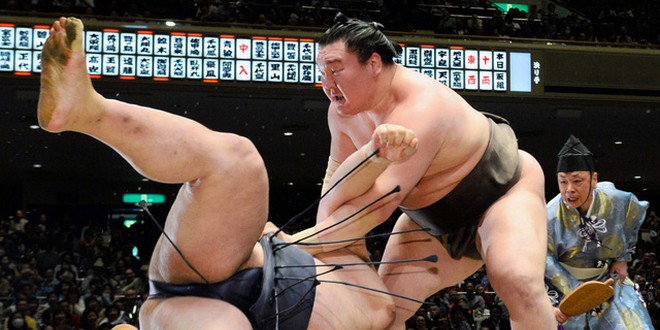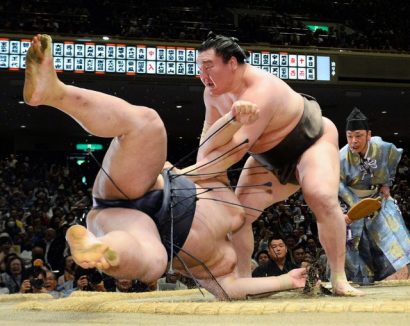

Hakuho contre Kisenosato
Natsu basho 2016 : résultats de la treizième journée


Le yokozuna Hakuho a cet après-midi fait un grand pas vers son 37ème titre en mettant fin à l’égalité qu’il y avait depuis 12 jours entre lui et son rival Kisenosato.
A 31 ans, Hakuho a enfin pris l’avantage sur son grand rival Kisenosato vendredi en infligeant à l’ôzeki sa première défaite du tournoi. Le yokozuna s’impose en remportant 43 des 56 matchs disputés contre le japonais. Kisenosoto, némésis du grand champion qui l’avait interrompu après 63 victoires consécutives, s’est incliné une nouvelle fois face au yokozuna déterminé à poursuivre son record de yûshô.
Kisenosato est de longue date perçu comme le meilleur espoir à devenir le prochain yokozuna japonais.
Hakuho n’a pas ménagé son tachai en donnant une gifle dès les premiers instants avant de se cramponner avec détermination au mawashi de Kisenosato. L’ôzeki a tenté tout se qu’il pouvait pour essayer de basculer le champion et de le faire sortir de l’anneau mais en vain. Hakuho a finalement exécuté une projection pour arracher, à l’issu d’un combat passionnant, sa treizième victoire.
Hakuho contre Kisenosato – treizième journée du natsu basho 2016
Demain Hakuho rencontrera son compatriote Harumafuji. Bien qu’ayant un net avantage (32-20), les chances de remporter le titre pour Hakuho se sont pas encore garanties à 100%. Kisenosato fera face samedi au yokozuna Kakuryu qu’il a battu 30 fois en 45 matchs.
Dans l’avant dernier match du jour, Harumafuji est arrivé à sa troisième défaite vaincu par son compatriote mongol Kakuryu. Avec leur score actuel, les deux hommes ont perdu tous espoirs de remporter dimanche le titre.
Harumafuji, qui conservait de minces espoirs de gagner le championnat, a été rapidement sorti par Kakuryu. Malgré un bon départ, Harumafuji s’est vite effondré en perdant son équilibre avant de se faire facilement expulser du dohyô.
Dans les autres rencontres de la journée, Kotoshogiku est parvenu à atteindre une majorité de victoires face au malheureux Terunofuji. L’ôzeki mongol enchaîne 11 défaites d’affilée, le plus mauvais résultat de sa carrière.
Goeido a également amélioré son score à 8-5 en condamnant le nouveau sekiwake Ikioi vers sa 10ème défaite. L’ôzeki a immédiatement pris le contrôle de la situation dès la charge initiale et a poussé avec succès hors de l’anneau son adversaire mais quand Ikioi a résisté, Goeido a eu recours à une projection. C’était la onzième victoire de Goeido face à Ikioi en 12 matchs disputés.
Le jeune Mitakeumi, toujours très encouragé par ses supporters, a obtenu une victoire confortable contre Nishikigi.
Après avoir terminé le précédent tournoi chez les jûryô avec un score de 11-4, Endo continue son retour spectaculaire en makuuchi avec aujourd’hui sa dixième victoire.
En jûryô justement, c’est toujours le duo Chiyonokuni et Sato qui dominent la division avec un score de 11-2. Akiseyama, certes toujours dernier, est parvenu à sa première victoire du championnat.
Les premiers yûshô sont arrivés dans les divisions inférieures dont voici les vainqueurs :
Les lutteurs kachi koshi du jour sont
:
Les lutteurs make koshi du jour sont :
Yokozuna Hakuho put himself in the driver’s seat for his 37th career championship on Friday, when the Summer Grand Sumo Tournament officially became a two-man race.
In the penultimate bout of the day at Tokyo’s Ryogoku Kokugikan, Harumafuji fell to his third loss, defeated by fellow Mongolian yokozuna Kakuryu to leave the title race in the hands of the last two men to do battle after 13 days.
The 31-year-old Hakuho, who holds the record for most grand championships following his win in March’s Osaka tourney, has for the most part beaten Kisenosato like a drum. Hakuho entered Friday’s showdown at the 15-day tournament with a 42-13 career record against the ozeki. But one of those 13 losses, in November 2010, had famously snapped Hakuho’s 63-bout winning streak.
The 29-year-old Kisenosato, long held up as the best hope for the ancient sport’s next native-born yokozuna, saw his record fall to 12-1.
Hakuho looked sloppy on the tachiai and appeared set to pay the price as the ozeki clung to his belt with iron determination. But try as he could, Kisenosato could neither tip his man over nor force him out of the ring. As the bout wore on and Kisenosato appeared winded, Hakuho eventually executed an underarm throw to snatch a hard-won victory.
On Saturday, Hakuho will put his 32-20 career mark against Harumafuji on the line, while Kisenosato will face Kakuryu, whom he has beaten 30 times in 45 career bouts.
In the first all-yokozuna clash of the tournament, Harumafuji saw his record against Kakuryu (10-3) fall to 26-15. After a strong start, Harumafuji’s attack quickly fell apart and he found himself off balance, on the run and easily forced out.
In other matches among the sports elites, Kotoshogiku secured his winning record for the tournament by notching up an easy victory against injury-plagued fellow ozeki Terunofuji. The Mongolian has lost 11 straight since starting the tournament with two wins.
Ozeki Goeido also improved to 8-5 with a slick finishing throw to condemn new sekiwake, Ikioi, to his 10th loss. The ozeki controlled the bout from the tachiai and successfully fought off an attempted defensive throw at the edge of the ring. With everything going his way, Goeido worked his opponent back to the straw ridge, and when Ikioi dug in his heels, the ozeki applied a beautiful beltless arm throw. It was Goeido’s 11th win in 12 career bouts against his fellow Osaka native.
Popular new sekiwake Kotoyuki improved to 6-7 in a frantic slapping and shoving encounter with No. 4 maegashira and former sekiwake Yoshikaze (6-7).
Written by Kyodo
Crédits photo : Asahi
| Rikishis | Kimarite | Rikishis |
| | | tsukiotoshi 突き落とし | | | Jôkôryû 常幸龍 貴之 (Juryô 11) 4-9 | |
| Ura 宇良 (Juryô 13) 9-4 | | | oshidashi 押し出し | | | Amakaze 天風 (Juryô 9) 5-8 |
| Dewahayate | | | oshidashi 押し出し | | | Asahishô 旭日松 広太 (Juryô10) 7-6 |
| | | hatakikomi 叩き込み | | | Asasekiryû 朝赤龍 太郎 (Juryô 8) 6-7 | |
| Fujiazuma 富士東 和佳 (Juryô 7) 7-6 | | | tsukitaoshi 突き倒し | | | Tsurugisho 剣翔 (Juryô 10) 6-7 |
| Ishiura 石浦 将勝 (Juryô 6) 7-6 | | | tsukidashi 突き出し | | | Sato 佐藤 (Juryô 13) 11-2 |
| Tenkaiho 天鎧鵬 貴由輝 (Juryô 14) 4-9 | | | okuridashi 送り出し | | | Akiseyama 明瀬山 光彦 (Juryô 5) 1-12 |
| Kagayaki 輝 大士 (Juryô 5) 8-5 | | | hikiotoshi 引き落とし | | | Chiyomaru 千代丸 (Juryô 12) 8-5 |
| Kitaharima 北はり磨 聖也 (Juryô 4) 8-5 | | | sukuinage 掬い投げ | | | Azumaryu 東龍 強 (Juryô 8) 8-5 |
| Kitataiki 北太樹 明義 (Juryô 6) 4-9 | | | okuridashi 送り出し | | | Arawashi 荒鷲 毅 (Juryô 3) 7-6 |
| Chiyonokuni 千代の国 (Juryô 3) 11-2 | | | hatakikomi 叩き込み | | | Asabenkei 朝弁慶 (Juryô 11) 9-4 |
| Toyohibiki | | | tsukidashi 突き出し | | | Chiyoshoma 千代翔馬 (Juryô 2) 6-7 |
| Sadanofuji 佐田の富士 哲博 (Juryô 4) 8-5 | | | oshitaoshi 押し倒し | | | Satoyama 里山 浩作 (Juryô 1) 5-8 |
| Homarefuji 誉富士 歓之 (Juryo 1) 6-7 | | | oshidashi 押し出し | | | Chiyoo 千代皇 (Juryô 7) 6-7 |
MAKUUCHI
| Rikishis | Kimarites | Rikishis |
| Seiro 青狼 武士 (Maegashira 14) 5-8 | | | oshidashi 押し出し | | | Amuru 阿夢露 光大 (Maegashira 12) 3-6-4 |
| Chiyootori 千代鳳 祐樹 (Maegashira 11) 6-7 | | | hikiotoshi 引き落とし | | | Takekaze 豪風 旭 (Maegashira 12) 7-6 |
| Sadanoumi | | | uwate dashinage 上手出し投げ | | | Gagamaru 臥牙丸 勝 (Maegashira 15) 6-7 |
| Sokokurai 蒼国来 栄吉 (Maegashira 9) 5-8 | | | uwatenage 上手投げ | | | Chiyotairyû 千代大龍 秀政 (Maegashira 16) 5-8 |
| Nishikigi 錦木 徹也 (Maegashira 14) 5-8 | | | yorikiri 寄り切り | | | Mitakeumi 御嶽海 (Maegashira 8) 9-4 |
| Daishomaru 大翔丸 翔伍 (Maegashira 13) 9-4 | | | hatakikomi 叩き込み | | | Osunaarashi 大砂嵐 金太 (Maegashira 7) 7-6 |
| | | oshidashi 押し出し | | | Endo 遠藤 聖大 (Maegashira 15) 10-3 | |
| Hidenoumi 英乃海 拓也 (Maegashira 13) 3-10 | | | hatakikomi 叩き込み | | | Tamawashi 玉鷲 一朗 (Maegashira 6) 3-10 |
| Daieisho 大栄翔 勇人 (Maegashira 9) 6-7 | | | yorikiri 寄り切り | | | Takayasu 高安 晃 (Maegashira 5) 9-4 |
| Tochiôzan 栃煌山 雄一郎 (Maegashira 5) 7-6 | | | sukuinage 掬い投げ | | | Shôhôzan 松鳳山 裕也 (Maegashira 11) 9-4 |
| Tokushôryû | | | yoritaoshi 寄り倒し | | | Tochinoshin 栃ノ心 剛 (Maegashira 4) 9-4 |
| Aoiyama | | | hatakikomi 叩き込み | | | Takanoiwa 貴ノ岩 義司 (Maegashira 6) 5-8 |
| Myogiryu 妙義龍 泰成 (Maegashira 1) 4-9 | | | yorikiri 寄り切り | | | Shodai |
| Takarafuji 宝富士 大輔 (Maegashira 1) 6-7 | | | yorikiri 寄り切り | | | Okinoumi 隠岐の海 歩 (Komusubi) 4-9 |
| Kaisei 魁聖 一郎 (Komusubi) 6-7 | | | yorikiri 寄り切り | | | Ichinojo 逸ノ城 駿 (Maegashira 2) 5-8 |
| Kotoyuki | | | tsukidashi 突き出し | | | Yoshikaze 嘉風 雅継 (Maegashira 4) 6-7 |
| Kotoshôgiku 琴奨菊 和弘 (Ozeki) 8-5 | | | yorikiri 寄り切り | | | Terunofuji 照ノ富士 (Ozeki) 2-11 |
| Ikioi 勢 翔太 (Sekiwake) 3-10 | | | sukuinage 掬い投げ | | | Gôeidô 豪栄道 豪太郎 (ôzeki) 8-5 |
| Harumafuji 日馬富士 公平 (Yokozuna) 10-3 | | | yorikiri 寄り切り | | | Kakuryû 鶴竜 力三郎 (Yokozuna) 10-3 |
| Hakuhô 白鵬 翔 (Yokozuna) 13-0 | | | shitatenage 下手投げ | | | Kisenosato 稀勢の里 寛 (Ozeki) 12-1 |
| Le site français du sumo |
Onosato surmonte la pression et décroche son troisième titre Le vainqueur du tournoi de printemps,…
Deux lutteurs ukrainiens ont fait forte impression au tournoi d'Osaka Deux lutteurs venant d'Ukraine, pays…
J15 – Onosato remporte le titre grâce à une victoire en kettei-sen contre Takayasu L’ôzeki…
J14 – Onosato gagne, Takayasu perd : égalité en tête avant la dernière journée L’ôzeki Onosato…
J13 – Takayasu en bonne place pour remporter sa première Coupe de l'Empereur après la…
J12 – Onosato bat Takerufuji et prend la tête du duel face à Takayasu L’ôzeki…
This website uses cookies.
View Comments
J'ai mal à mon Terunofuji...